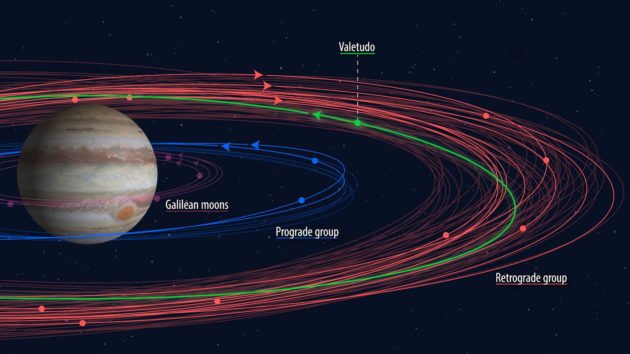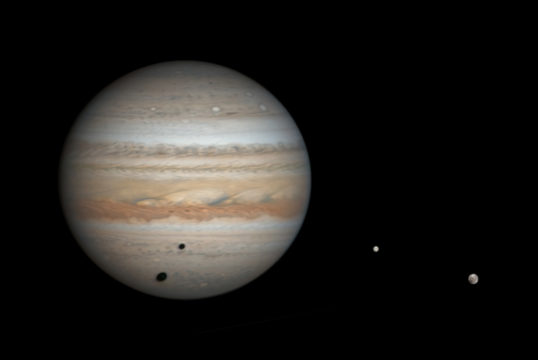An amateur astronomer has discovered a new moon of Jupiter. While it hasn’t received official designation yet, it would bring the tally of Jovian satellites to 80.
| UPDATE: On November 15, 2021, the Minor Planet Center’s MPEC 2021-V333 announced the discovery of S/2003 J 24. Although not specifically called out as one of the object’s co-discoverers, Kai Ly is listed twice as a “measurer” of archival telescopic observations — including the data from 2003 on which the object was originally recorded. |
The amateur astronomer who last year recovered four lost Jovian moons has become the first amateur to discover a previously unknown moon. Kai Ly reported the discovery to the Minor Planet Mailing List on June 30th and has submitted it for publication as a Minor Planet Electronic Circular.
Ly's quest was a spin-off of their earlier identification of pre-recovery images of recently discovered Jovian moons including Valetudo, Ersa, and Pandia while examining data taken with the 3.6-meter Canada-France-Hawaii Telescope (CFHT). David Jewitt and Scott Sheppard (both then at University of Hawai‘i) had led a group that used these images to discover 23 new moons, which they announced in 2003. The images remain available online, and Ly thought that more undiscovered moons might be hiding in the data set.

Carnegie Inst. for Science / Roberto Molar Candanosa
After planning their search in May, Ly in early June started examining images taken in February 2003, when Jupiter was at opposition and its moons were brightest. They examined three survey images covering the same region of the sky at different times on the night of February 24th and found three potential moons moving at 13 to 21 arcseconds per hour during the night.
Ly could not recover two of the potential moons on other nights, but did find the third, temporarily designated EJc0061, on survey observations on February 25 to 27, and on images taken with the Subaru Telescope on February 5 and 6. That established a 22-day arc that suggested the object was bound to Jupiter.
Ly thus had enough information to trace the moon’s orbit on survey images from March 12 to April 30. “From there on, the orbit and ephemeris quality was decent enough for me to begin searching observations beyond 2003,” Ly says. They found the moon near its predicted position in later images from the Subaru, CFHT, and Cerro Tololo Inter-American Observatory taken through early 2018. The faint moon ranges from magnitude 23.2 to 23.5.
The end result was an arc of 76 observations over 15.26 years (5,575 days), enough for Ly to consider its orbit well-secured for decades. The data track the moon — provisionally designated S/2003 J 24 pending publication — through nearly eight 1.9-year orbits of Jupiter, says David Tholen (University of Hawai‘i), more than enough to show it's a moon. Tholen has not checked the images, but says the evidence seems solid: “It would be nearly impossible for artifacts to fit a Jovicentric orbit over so many different nights using different cameras.”

“I’m proud to say that this is the first planetary moon discovered by an amateur astronomer!” says Ly. But otherwise, they admit, “it's just a typical member of the retrograde Carme group.” This group includes 22 other small moons orbiting Jupiter in the opposite direction of its spin with periods of around two years. Their orbits are similar enough to suggest they were all fragments from a single impact. They’re probably chips off Carme, the first of the group to be discovered and at 45 kilometers across, by far the largest.
Such small retrograde Jovian moons may have plenty of company awaiting discovery. Last year, Edward Ashton, Matthew Beaudoin, and Brett J. Gladman (University of British Columbia, Canada) spotted some four dozen objects as small as 800 meters across that appeared to be orbiting Jupiter. They did not follow them long enough to prove the objects were Jovian moons, but from their preliminary observations, they suggested that Jupiter could have some 600 satellites at least 800 meters in diameter. The development of bigger and more sensitive telescopes will create room for new discoveries, Tholen says.

IPAC Infrared Science Archive / NASA / JPL-Caltech
Ly describes their moon-hunting as “a summer hobby before I return to school.” They hope to find more, but with more data than they can process by themselves from the February 2003 observations alone, they decided to publicize their results to raise interest.
Amateur Sam Deen is “quite impressed” with Ly's accomplishment. He adds that when observatories post survey data openly, it creates more opportunities for amateurs to make discoveries. “The main obstacle is just getting to know what you're doing and having the tolerance to go looking through the data for hours before turning up anything worthwhile,” he says.
Software and services can aid in interpreting the results, including the Find_Orb orbit determination software, the interactive Aladin Sky Atlas, the Minor Planet Center's many services, and the Canadian Astronomical Data Center's Solar System Object Image Search. The field is open for amateur astronomers to make their own discoveries.
 0
0









Comments
You must be logged in to post a comment.